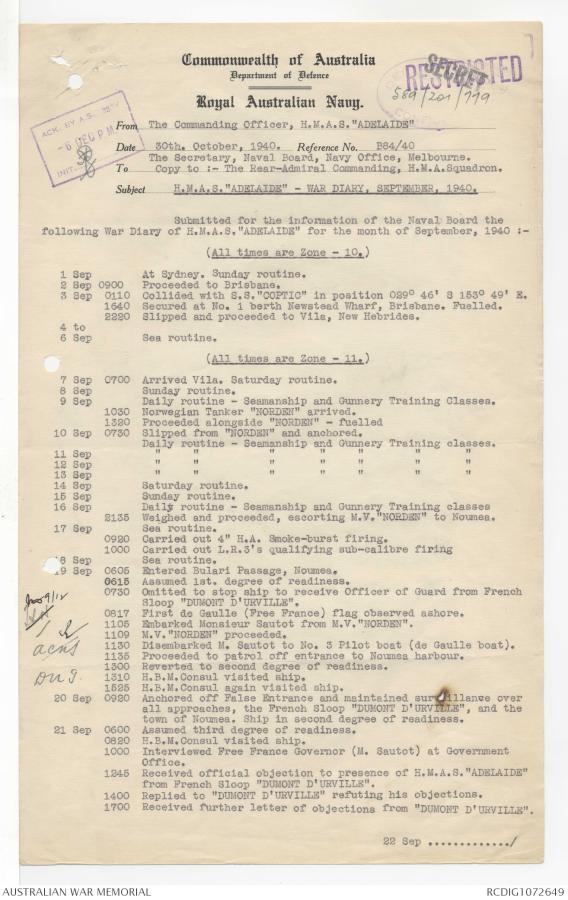A versatile ship: HMAS Adelaide’s service during the Second World War
The light cruiser HMAS Adelaide had seen service by the start of the Second World War. Built at the end of the First World War, it had been re-fitted and updated several times, as well as participating in policing actions in the British Solomon Islands Protectorate, and trans-Tasman exercises with New Zealand. Adelaide would see action in the Second World War, participate in training exercises, and become a reliable escort along shipping routes around Australia and the near region.
The ship’s Report of Proceedings for the early war-time months records a busy schedule, including dockyard works, fuel-consumption trials, and gunnery exercises. Serving officers and enlisted ranks were required to make ready for extended times on board and to be prepared for inspection visits by high-ranking officers.
On 28 November 1942, Adelaide’s regular convoy-escort duties were dramatically interrupted. While steaming along the coast of Western Australia with the Dutch ship Heemskerck, Adelaide encountered an enemy vessel. It was the German ship Ramses, which had been blockade-breaking in the South China Sea and South-West Pacific. Ramses was sighted by the Adelaide’s company, and noted as suspicious. Adelaide moved closer once the navigation officer positively identified the German vessel. After crew on Ramses used explosive charges in an effort to sabotage the Allied ships, Heemskerck and Adelaide fired on the Ramses. Adelaide’s third round ensured the sinking of the targeted vessel. It was Adelaide’s only hostile wartime action against an enemy ship.
Port side view of the German blockade runner Ramses. Note the swastika on her side. AWM 305809.
After the sinking, 78 crew members and ten German prisoners of war were rescued from the ocean, along with a pig and a dog. The prisoners were handed to authorities when the ship berthed at Fremantle on 2 December 1942. Adelaide had proven its versatility through service as a patrol vessel, an attacking force, a rescue ship, and in a guard role for overseeing captured enemy personnel.
As the war continued, Adelaide was based at Fremantle. The ship escorted all kinds of naval vessels and civilian ships, including ocean liners converted for wartime use as troopships. Mauretania, Aquitania, and French luxury liner Ile De France, were escorted between Australia and Allied-controlled ports, such as Bombay, or other Australian ports during January and February 1943. These escort journeys could take several days, before the ship’s crew handed the duty to another naval vessel.
Adelaide also participated in at-sea and coastal exercises. The ship’s reports records training with the British Royal Navy, American and Dutch ships, and Allied submarines, especially from 1943 onwards. For these exercises, Adelaide would typically leave port at Fremantle and join other nations’ vessels at sea, or near coastal features such as Rottnest Island. Radar tracking, navigation, ship-to-shore communications, and combined-forces manoeuvres were practised with the crews gaining potentially lifesaving experience.
By the end of the war, Adelaide and its complement had travelled more than 378,000 kilometres around Australian waters and the South-West Pacific. Allied naval and commercial ships had been safely escorted. The enemy ship, Ramses, had been sunk, and her crew captured. The ship’s complement gained considerable experience in a wide range of naval skills and duties. Adelaide had been lucky to be based in Fremantle for most of the war. This had likely spared it the disastrous fate of HMAS Sydney and HMAS Perth.
Despite refits and earlier years in reserve, by the end of 1945 Adelaide had become too worn and obsolete to be viable for a major postwar role. In 1946 the ship sailed to Sydney and was de-commissioned, ultimately being scrapped in 1950.
For those serving on Adelaide during the war, there were many reasons to be proud of their dedicated service and their ship. The ship’s Reports of Proceedings is available to view online via the Memorial's Digitised Collection.


